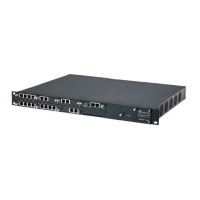SIP User's Manual 254 Document #: LTRT-12804
Mediant 800 MSBG
The matching of packets by rules is connection-based, known as Stateful Packet
Inspection (SPI), using the same connection-tracking mechanism used by the device's
firewall. Once a packet matches a rule, all subsequent packets with the same attributes
receive the same QoS parameters, both inbound and outbound. A packet can match more
than one rule. Therefore:
The first class rule has precedence over all other class rules (scanning is stopped
once the first rule is reached).
The first traffic-priority (classless) rule has precedence over all other traffic-priority
rules.
There is no prevention of a traffic-priority rule conflicting with a class rule. In this case,
the priority and DSCP setting of the class rule (if given) takes precedence.
Tx Traffic Shaping classes can be assigned to Matching Rules. These classes are defined
in ''Configuring Traffic Shaping'' on page 256.
Con
nection-based QoS also allows inheriting QoS parameters by some of the applications
that open subsequent connections. For instance, you can define QoS rules on SIP, and the
rules also apply to both control and data ports (even if the data ports are unknown). This
feature applies to all applications that have ALG in the firewall such as SIP, MSN
Messenger/Windows Messenger, Port Triggering applications (see ''Configuring Port
Triggering'' on page 244),
PPTP, and IPSec.
¾ To define matching-of-packet rules:
1. Click the Match Rules item (Configuration tab > Data menu > QoS submenu >
Match Rules); the following page appears:
Figure 3-162: Configuring Traffic Priority
This page is organized into two groups - 'QoS Input Rules' and 'QoS Output Rules' -
for prioritizing inbound and outbound traffic, respectively. Each group lists all the
devices on which rules can be set. You can set rules on all devices using the 'All
Devices' group.

